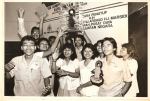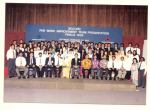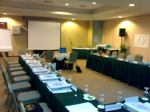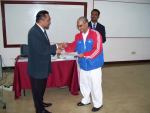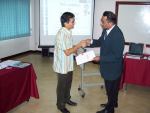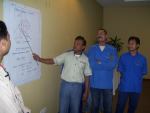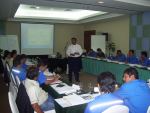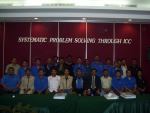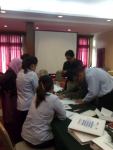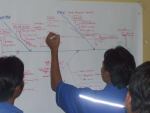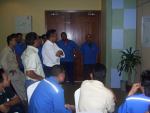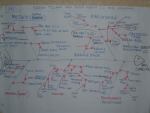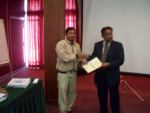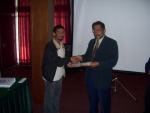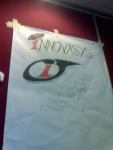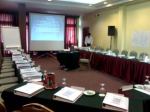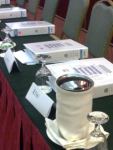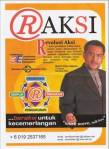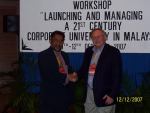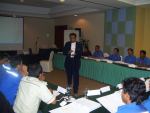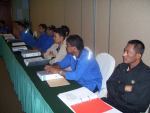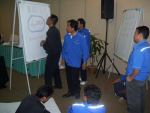Kris
From Wikipedia, the free encyclopedia
For other uses of the word “kris”, see Kris (disambiguation). For other uses of the word “KERIS”, see KERIS (disambiguation).
Kris from Yogyakarta – Dapur Carubuk
The kris or keris is an asymmetrical dagger or sword most strongly associated with the culture of Indonesia, but also indigenous to Malaysia, Southern Thailand andBrunei. It is known as kalis in the southern Philippines. The kris is famous for its distinctive wavy blade (luk), but many have straight blades as well. The numbers ofluks is always odd numbered,[1] ranged from three to thirteen waves, however there are also luks that reach 29.[2] A kris can be divided into three parts: bilah (blade),hulu (hilt), and warangka (sheath). These parts of the kris are objects of art, often carved in meticulous detail and made from various materials; metal, precious or rare types of wood, or gold or ivory. A kris’s aesthetic value covers the dhapur (the form and design of the blade, with around 150 variants), the pamor (the pattern of metal alloy decoration on the blade, with around 60 variants), and tangguh referring to the age and origin of a kris.[3]
Both a weapon and spiritual object, krises are often considered to have an essence or presence, considered to possess magical powers, with some blades possessing good luck and others possessing bad.[3] Krises are used for display, as talismans with magical powers, weapons, a sanctified heirloom (pusaka), auxiliary equipment for court soldiers, an accessory for ceremonial dress, an indicator of social status, a symbol of heroism, etc.[3] Legendary krises that possess supernatural power and extraordinary ability were mentioned in traditional folktales, such as the krises of Mpu Gandring, Taming Sari, and Setan Kober.
In 2005, UNESCO gave the title Masterpiece of the Oral and Intangible Heritage of Humanity to the kris of Indonesia. In return, UNESCO urged Indonesia to preserve their heritage.[3]
Etymology
The origin of the word kris derives from the old Javanese term ngiris which means to stab, wedge or sliver. “Kris” is the more frequently-used spelling in the West, but “keris” is more popular in the dagger’s native lands,[4] as exemplified by the late Bambang Harsrinuksmo‘s popular book entitled Ensiklopedi Keris (Keris Encyclopedia). Two notable exceptions are the Philippines, where it is usually called kalis or kris, and Thailand where it is always spelled and pronounced as kris. Other spellings used by European colonists include “cryse”, “crise”, “criss”, “kriss” and “creese”.
History
Origins
Kris depicted on Borobudur bas-relief.
Kris history is generally traced through the study of carvings and bas-relief panels found in Southeast Asia. It is believed that the earliest kris prototype can be traced to Dong Son bronze culture in Vietnam circa 300 BC that spread to other parts of Southeast Asia. Another theory is that the kris was based on daggers from India.[5] Some of the most famous renderings of a kris appear on the bas-reliefs of Borobudur (825 CE) and Prambanan temple (850CE). However from Raffles‘ (1817) study of the Candi Sukuh that the kris recognized today came into existence around 1361 AD in the kingdom of Majapahit, East Java. The scene in bas relief of Sukuh Temple in Central Java dated from 15th century Majapahit era, shows the workshop of a Javanese keris blacksmith. The scene depicted Bhima as the blacksmith on the left forging the metal, Ganesha in the center, and Arjuna on the right operating the piston bellows to blow air into the furnace. The wall behind the blacksmith displays various items manufactured in the forge, including kris. These representations of the kris in Candi Sukuh established the fact that by the year 1437 the kris had already gained an important place within Javanese culture.
There exist claims of earlier forms predating the Majapahit kris but none are verifiable. In the past, the majority of kris had straight blades but this became less frequent over time. Some of the most famous renderings of a kris appear on the Borobudur temple (825 CE) and Prambanan temple (850CE). Tomé Pires, in early 16th century, describe the importance of Kris to the Javanese: [6]
… every man in Java, whether he is rich or poor, must have a kris in his house .. and no man between the ages of 12 and 80 may go out of doors without a kris in his belt. They carry them at the back, as daggers used to be in Portugal…
— Tome Pires, Suma Oriental
Kris blacksmith’s workshop depicted in 15th century Candi Sukuh.
Kris display
Kris were worn on a daily basis, especially when travelling because it might be needed for self-defense against wild animals or bandits. During wartime it is the weapon of choice together with kris-edged spear (tombak). During time of peace, people wore kris as part of ceremonial attire. Ceremonial kris oftern meticulously decorated with intricate carving in gold and precious stones. Heirloom blades were handed down through successive generations and worn during special events such as weddings and other ceremonies. Men usually wore only one kris but the famous admiral Hang Tuah is said in the Hikayat Hang Tuah to have armed himself with one short and one long kris. As women were also permitted to learn silat, they sometimes also wore kris, though of a smaller size than a man’s. In battle, a fighter might carried more than one kris, some carried three kris: his own, one from his father-in-law, and one as a family heirloom. The extra two served as parrying daggers but if none were available, the sheath would serve the same purpose.
Kris were often broken in battle and required repairs. Yearly cleanings, required as part of the spirituality and mythology surrounding the weapon, often left ancient blades worn and thin. The repair materials depended on location and it is quite usual to find a weapon with fittings from several areas. For example, a kris may have a blade from Java, a hilt from Bali and a sheath from Madura.
In many parts of Indonesia, the kris was the choice weapon for execution. The executioner’s kris had a long, straight, slender blade. The condemned knelt before the executioner, who placed a wad of cotton or similar material on the subject’s shoulder or clavicle area. The blade was thrust through the padding, piercing the subclavian artery and the heart. Upon withdrawal, the cotton wiped the blade clean. Death came within seconds.
In 16th century, European colonial power introduced firearms into the archipelago that contribute to the decline of kris’ prominence as the weapon of choice in battle. However its spiritual and ceremonial function still continued and celebrated mainly in kratons and istanas (courts) throughout Indonesia and Malaysia.
Kris today
Until the 1990s, kris-making activities in Java had almost come to a standstill due to economic difficulties and changing socio-cultural values. However, thanks to several concerned kris experts, the tradition is being revived and kris craftsmanship has increased again.
Over the past three decades, krises have lost their prominent social and spiritual meaning in society. Although active and honoured empus who produce high quality krises in the traditional way can still be found on some places such Madura, Surakarta, Yogyakarta, Makassar And Palembang, their number is dramatically decreasing, and it is more difficult for them to find successors to whom they may transmit their skills.[3]
Description
A kris’ aesthetic value covers the dhapur (the form and design of the blade, with around 150 variants), the pamor (the pattern of metal alloy decoration on the blade, with around 60 variants), and tangguhreferring to the age and origin of a kris.[3]
Blade
A decorative kris with a figure of Semaras the handle. The bilah has thirteen luk.
Kris blade is called wilah or bilah. Kris blades are usually narrow with a wide, asymmetrical base. Kris is famous for its wavy blades (luk), however the older types of kris dated from Majapahit era are straight blades ones.[7] The numbers of luks is always odd numbered,[1] the common numbers of luks ranged from three to thirteen waves, however there is also luks that reach 29.[2] Today the wavy blade kris is more commonly found than the straight ones. The exact purpose of wavy blade is unknown. It was suggested that wavy blade is symbolize both fire and water, the two elements present during the forging of metal blade. In Bali kris is associated with Nāga (dragon serpent) which also symbolyze irrigation canals, rivers, springs, wells, spouts, waterfalls and rainbows, thus the wavy blade symbolyze the movement of the serpent. Some keris have a naga or serpent head carved near its base with the body and tail following the curves of the blade to the tip. A wavy kris is a naga in motion, aggressive and alive; a straight blade is one at rest, its power dormant but ready to come into action.[8]
Another theory suggested that the wavy blade design was meant to inflict severe wound upon victim. During keris stabbing, the wavy blades severes more blood vessels, creating wider wound which caused the victim to easily bleed to death. However in older Javanese tradition it is also common to apply various types of poisons upon keris blade, which can inflict more potent mortality upon battle.
Different types of whetstones, acidic juice of citrus fruits and poisonous arsenic bring out the contrast between the dark black iron and the light colored silvery nickel layers which together form pamor, damascene patterns on the blade. The distinctive pamor patterns has specific meanings and names which indicate their special magical property.
Hilt
Richly decorated Balinese kris hilt coated with gold, adorned with rubies
Kris handle or hilt (hulu keris) is the object of art, often carved in meticulous details and made from various materials; precious rare types of wood to gold or ivory. In Bali kris handle is carved in demon-like creature coated in gold and adorned with semi precious and precious stones, such as rubies. In Java kris handle is made in various type, the most common design is the abstract stylized representation of human. The example of kris hilt styles such as Tunggak Semi Putri Kinurung hilt from Surakarta, Hulu keris Batara Guru and Pulasir from Madura, hulu keris Punukan from Palembang, Ratmaja from Bali, hulu keris Pulungan from Cirebon, and seabird-like hilt from Lampung and Sulawesi.[9]
The kris usually has a curved pistol-grip hilt that aids in stabbing strikes. It allows the palm of the holding hand to add pressure to the blade while stabbing. A kris only offers minimal protection for the hand by the broad blade at the hilt. In rare cases, the blade may be forged so its axis lies at an angle to the hilt’s axis. The intention is to get the blade automatically turning to slip past the ribs but this works poorly and makes the weapon less durable.[citation needed]
Sheath
Just like kris hilt, its sheath (warangka) is also the object of art. It can be made from various materials, usually wooden frame to hold the blade which can be coated with metals; such as brass, iron, silver, or even gold, usually carved in sulur floral motifs. The upper part of sheath formed a broad curved handle made from wood or sometimes ivory. It could be adorned with precious or semi-precious stones.
Kris making
The making of a kris was the specialised duty of metalworkers called empu or pandai besi. In Bali this occupation was preserved by the Pande clan to this day, members of whom also made jewellery. A blade smith, or empu, makes the blade in layers of different iron ores and meteorite nickel. Some blades can be made in a relatively short time, while more legendary weapons take years to complete. In high quality kris blades, the metal is folded dozens or hundreds of times and handled with the utmost precision. Empu are highly respected craftsmen with additional knowledge in literature, history, the occult, etc.[3]
Cultural beliefs
Various ways of wearing kris inJavanese culture.
Barong dance performance with kris-wielding dancers and Rangda in Bali
Krises were worn at special ceremonies, with heirloom blades being handed down through successive generations. Both men and women might wear them, though those for women are smaller. A rich spirituality and mythology developed around the weapon. Krises are used for display, as talismans with magical powers, weapons, sanctified heirloom, auxiliary equipment for court soldiers, as an accessory for ceremonial dress, an indicator of social status, a symbol of heroism, etc.[3]
In Javanese culture kris is revered as tosan aji (Javanese for “sacred heirloom weapon”) and considered as pusaka. Kris is believed to have ability to infused bravery upon its holder, this property is known as piyandel in Javanese which means “to add self-confidence”. The pusaka kris or kris-tipped spear given by a Javanese king to nobles or his subjects, was meant to symbolize the king’s confidence bestowed upon the receiver and considered as a great honor. During Javanese wedding ceremony, kris is required to be adorned with chains of jasmine flower arrangement as an important part of Javanese groom’s wedding costume. The addition of jasmine arrangement around the kris was meant as a symbol that a man should not easily be angry, cruel, fierce, too aggressive, tyrannical and abusive.[2]
Kris-makers did more than forge the weapon, they carried out the old rituals which could infuse the blade with mystical powers. For this reason, kris are considered almost alive because they may be vessels of spirits, either good or evil. Legends tell of kris that could move of their own volition and killed individuals at will. Some kris are rumored to stand upright when their real names are called by their masters. It was said that some kris helped prevent fires, death, agricultural failure, and many other problems. Likewise, they could also bring fortune, such as bountiful harvests. Many of these beliefs, however, were erroneously derived from the possession of different kris by different people. For example, there is a type of kris in Java that was called Beras Wutah, which was believed to grant its possessor an easy life without famine. In reality, this kris was mainly assigned to government officers that were paid, in whole or in part with foodstuff such as rice.
There are several ways of testing whether a kris is lucky or not. A series of cuts on a leaf, based on blade width and other factors, could determine if a blade was good or bad. Also, if the owner slept with the blade under their pillow, the spirit of the kris would communicate with the owner via dream. If the owner had a bad dream, the blade was unlucky and had to be discarded, whereas if the owner had a good dream the dagger would bring good fortune. However, just because a blade was bad for one person didn’t mean it would be bad for another. Harmony between the weapon and its owner was critical.
Because some kris are considered sacred and believed to possess magical powers, specific rites needed to be completed to avoid calling down evil fates which is the reason warriors often made offerings to their kris at a shrine. There is also the belief that pointing a kris at someone means they will die soon, sosilat practitioners precede their demonstrations by touching the points of the blades to the ground so as to neutralise this effect.
In Balinese Barong dance there is a segment called the “keris dance”. The Rangda evil character appear and casting black magic upon male dancers that represents Airlangga‘s soldier ordering them to commit suicide. In trance these men stab themself on their chest with their own kris, while Barong and the priest casting magic to protect these men by making them invulnerable to sharp objects. The Balinese dance depicting the battle between Barong and Rangda is to represent the eternal struggle between good and evil.[10]
Legends
Several folktales — linked to historical figures — were mentioning about the legendary krises that possess supernatural power and extraordinary ability. Most of the magical krises are from Javanese origin, while the tales are derived from Javanese ancient manuscript, Babad (Javanese chronicle) and Malay Annals.
Keris Mpu Gandring
One of the most famous legends from Java derived from Pararaton (The Book of Kings), describes a legendary bladesmith called Mpu Gandring and his impatient customer, Ken Arok, that took place during the end of Kediri kingdom. The customer ordered a powerful kris to kill the mighty chieftain of Tumapel, Tunggul Ametung. Ken Arok eventually stabbed the old bladesmith to death because he kept delaying the scheduled completion of the kris. Dying, the bladesmith cursed the kris through prophesied that the unfinished or incomplete kris would kill seven men, including Ken Arok. Ken Arok uses the Mpu Gandring’s cursed kris to assassin Tunggul Ametung, cunningly put the blame to Kebo Ijo, and build a new kingdom of Singhasari. The prophecy finally came true, with four men enlisted as the kris’ first death roll, including Mpu Gandring himself, Tunggul Ametung, Kebo Ijo to whom Ken Arok lent the weapon, and finally Ken Arok himself. The unfinished kris then disappeared.[11][12]
Another version of the tale describes that the kris passed to Ken Arok‘s stepson Anusapati which in turn killed his stepfather after recognized that his genuine father was killed by Ken Arok with the same kris. The bloody revenge continued on and on until the reign of Kertanegara, the last king of Singhasari kingdom.
Keris Taming Sari
The Keris Taming Sari (translation: Flower Shield Kris) (Taming Sari’s kris) is one of the most well-known kris in Malay literature, said to be so skilfully crafted that anyone wielding it was unbeatable. In some versions of the legend, the weapon would grant its user physical invulnerability. The legend took place sometimes during the fall of Majapahit Empire and the rise of Malacca Sultanate. Tun Sri Lanang‘s book, the Sejarah Melayu, tells that it was made by javanese empu and first used by the champion of Majapahit, a pendekar named Taming Sari. He was defeated in a duel to the death by the Melakan admiral Hang Tuah, after which the king of Majapahit presented the weapon to the victor.[1]
After being framed by a jealous official, Hang Tuah was ordered to be executed, but he managed to escape and go into hiding with the help of a minister who knew the truth. Hang Tuah’s kris and title ofLaksamana (admiral) were passed on to his comrade Hang Jebat. Furious that his best friend was unfairly put to death, Hang Jebat rebelled against the royalty and took over the palace. The desperate ruler of Melaka pardoned the minister so long as Hang Tuah could win him back the throne. Having trained under the same master since childhood the two friends were nearly equals but of the two, Tuah was the superior fighter. However, even after a long battle in the palace, neither could best the other because the Kris Taming Sari evened the odds. Only after taking his weapon back did Hang Tuah manage to stab Jebat, who died soon after.
Keris Setan Kober
Another Javanese folk story tells of Arya Penangsang, the mighty Adipati of Jipang who was killed by his own kris called Keris Setan Kober (Javanese for: Devil of the Grave Kris). This kris is a powerful one with 13 luks and tangguh Pajajaran (created in kingdom of Pajajaran) by Mpu Bayu Aji, a skillful bladesmith. Near the finish when the Mpu tried to infuse spiritual power into the kris, he was disturbed by the crying demon (jinn) of the graveyard. As a result, although powerful, the kris is defective. Since Mpu Bayu Aji is so ambitious to create a powerful weapon, plus the disturbance from the devil, the kris has a temperamental evil nature that causes the wielder to be overly ambitious and impatient.
The story took place during the fall of Demak Sultanate that had replaced Majapahit as the ruler of Java. The Keris Setan Kober were safely kept by Sunan Kudus, one of nine Islamic saints of Java. However Sunan Prawoto, son of Prince Trenggana and grandson of Raden Patah, stole it and used it to assassinate his uncle Raden Kikin by the river, since then Raden Kikin also refer as Sekar Seda Lepen (flower that fell by the river). Raden Trenggana rise as Sultan and later after his death, replaced by Sunan Prawoto. Kikin’s son, Arya Penangsang of Jipang with the help of his teacher, Sunan Kudus, took revenge by sending an assassin to kill Prawoto using Keris Setan Kober. Prawoto younger sister Ratu Kalinyamat seeks revenge on Penangsang, since Penangsang also murdered her husband. She urged her brother in-law, Hadiwijaya (Joko Tingkir) the ruler of Pajang, to kill Arya Penangsang. Hadiwijaya sent his adopted son and also his son in-law Sutawijaya, who would later become the first ruler of the Mataram dynasty.
During a battle, Sutawijaya stabbed Penangsang with Kyai Plered spear right in his gut. Arya Penangsang is bathing in his own blood, and his intestines were hanging from his gut. However because Arya Penangsang is a mighty fighter that possess aji or kesaktian (spiritual power in martial art), he keep fighting with an open wounded stomach. He encircled his hanging intestines on his kris hilt, and continue to fight. When trying to attack his opponent, the reckless, fierce and impatience Panangsang pulled his own Keris Setan Kober off its sheath, foolishly cut his own intestines, and finally died.
The Javanese tradition of putting jasmine garlands chain around the kris’ hilt, especially on groom’s kris during the wedding ceremony, are actually derived from this tale. It is to symbolyze that the groom should not be reckless, easily get angry, impatient and abusive like Arya Panangsang.[2] To replace the intestine, the kris is coiled with a floral garland of jasmine chain that resemble intestine. The jasmine is to symbolize sacredeness, patience, grace, humility, kindness and benevolence, the qualities lack in Panangsang. However another source mentioned that actually Sutawijaya admired Penangsang’s fighting spirits, still fighting although his intestine encircled around his kris. Impressed by Penangsang’s deed, later he command his male descendants to follow his step, adorned the kris with “intestine” made from the chain of jasmine, as a symbol of bravery. The story of Arya Penangsang has inspired and performed as Javanese ketoprak drama.[13]
Kris as a symbol
Hishammuddin Hussein‘s infamous waving of the kris as a symbol of Malay supremacy at the 2005 United Malays National Organisation Annual General Meeting
Throughout the archipelago, kris is a symbol of heroism,[3] martial prowess, power and authority. As a cultural symbol, the meticulously decorated keris represent refinement, art and beauty, as the pride and prized possession for its owner;[2] however, as a weapon it is associated with violence, death and bloodshed. Probably for this reason, although the kris is widespread in Javanese culture, it is not used to symbolise Javanese culture or royalty, as Javanese tradition promotes harmony and discourages direct confrontation (hence the absence of knives on Indonesian dinner tables). This is also why the Javanese traditionally wear the kris on their back, to symbolize violence as the last resort. However, in other parts of archipelago, from Sumatra to the Malay Peninsula and to Sulawesi, the kris is worn on the front or left side on the hip.
The kris is depicted on different emblems, coats and logos. For example, it can be seen in historical flag of Mataram Sultanate and former emblem of Siam to represent Malay minority in Southern Thailand. Kris is displayed in emblems of Riau, Riau Islands Province, Terengganu and Selangor. It also can be seen on an obverse copper-zinc-tin RM1 coin with a songket pattern in the background. The Malaya and British Borneo dollar 1 cent coin of 1962 also depicted a pair of crossed kris.
Since the independence of Malaysia, the kris has become something of a symbol of Malay nationalism. It is still regarded by some as a symbol of ketuanan Melayu, the doctrine of Malay as the dominant race at their homeland, and has been incorporated into the Sang Saka Bangsa, the official flag of the United Malays National Organisation.[14]
Photograph showing Ramli ,Guest of Honour (Tan Sri Abu Sahid of Maju Holdings),all MahaGurus of Silat and Silat Exponents at Piala Tok Senik (National Silat Championships) held at Tok Senik Resort in Langkawi in 1999.
Videos on Keris in YouTube:

